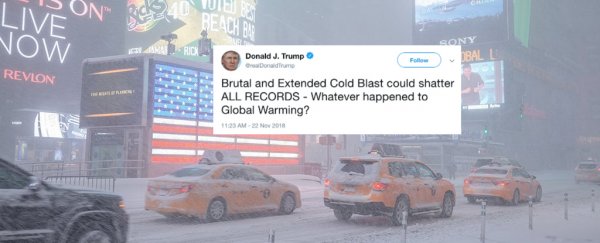We all have that one friend who uses localised weather, particularly cold snaps, as evidence climate change isn't happening. This week, that friend was President Donald Trump.
He took to Twitter to ask "whatever happened to global warming?" in reference to the record cold Thanksgiving parts of the US are expected to experience.
Brutal and Extended Cold Blast could shatter ALL RECORDS - Whatever happened to Global Warming?
— Donald J. Trump (@realDonaldTrump) November 22, 2018
This is the coldest weather in the history of the Thanksgiving Day Parade in NYC, and one of the coldest Thanksgivings on record!
— Donald J. Trump (@realDonaldTrump) November 22, 2018
In Trump's defence, it's an easy and very common mistake to make in science, taking a short patch of weather in a localised region and using it to make broad statements about the long-term climate patterns of the planet as a whole. It seems intuitive that if the planet is getting warmer, winters should get warmer too.
But this idea actually has no scientific backing, and it's a dangerous error that can detract and distract from the real science on climate change.
In fact, studies actually show that the opposite is true.
Warmer conditions in the Arctic actually coincide with colder winters in far North America, a correlation that demonstrates global climate change isn't as intuitive as many might otherwise imagine.
A 2017 study by an international team of researchers has found the consequences of these colder and drier winters go beyond a need to rug up – they're reducing the productivity of crops in lower latitudes.
More carbon dioxide in the atmosphere plus warmer conditions should by many accounts be good news for plants, especially as melting permafrost frees up new terrain. But this isn't entirely incorrect, at least as far as northern climates go.
When it comes to more distant regions, the impact of the Arctic's changing climate on temperate plant growth isn't as well studied.
Separated by thousands of kilometres, it might not seem all that important. But researchers know all too well that doesn't make much of a difference when it comes to climate.
El Niño is a classic example of what climatologists call teleconnection, where an anomaly in one part of the world, such as a change in air pressure around the Pacific island of Tahiti, can be linked with an anomaly thousands of kilometres away, such as air pressure around Darwin, Australia.
In recent decades, the Arctic has experienced more than its fair share of warming thanks to a phenomenon called Arctic amplification.
A loss of sea ice, hotter ocean currents, and increased atmospheric water vapour mean temperatures have risen twice as fast around northern latitudes.
These changes have also been associated with harsher winters much further south, a knock-on effect that often confuses people who assume global warming means we can all ditch our mittens.
This recent research has shown how above average temperatures in the Arctic lead to lower plant growth and decreased uptake of carbon dioxide in North American ecosystems.
The team confirmed the connection between anomalous weather patterns in North America and Arctic warming.
They then used a set of detailed models called Coupled Model Intercomparison Project Phase 5 (CMIP5) to identify a link between the anomalies and a drop in gross primary productivity.
In other words, it seems as if a warming Arctic produces colder winters with less precipitation, reducing the capacity for plants to take up CO2 by about 14 percent.
"Even though we're talking about the Arctic, it has immediate impacts on what we experience at lower latitudes," Anna Michalak from the US Carnegie Institution for Science told Sarah Gibbens at National Geographic.
What this ultimately means in terms of carbon sequestration is yet to be determined.
More research will be needed to see just how widespread this effect could be, but if we're hoping that more carbon dioxide will automatically make for a greener planet, it's looking a little more complicated.
It's also unlikely to be a simple relationship between Arctic temperatures and North American weather patterns, meaning more data is needed to shore up existing models.
In the meantime, the research could imply a need to consider frost resistant and drought tolerant crops in anticipation of plenty more cold, dry winters in the future.
With lower states such as California already experiencing tough drought seasons in the wake of low snow falls, water management strategies could be set in place during warm spells in the Arctic.
One thing is for certain – global warming knows no borders. We're all in this together.
This research was published in Nature Geosciences.
An earlier version of this story was published in July 2017.
